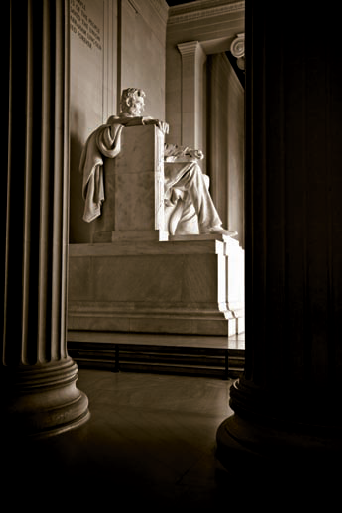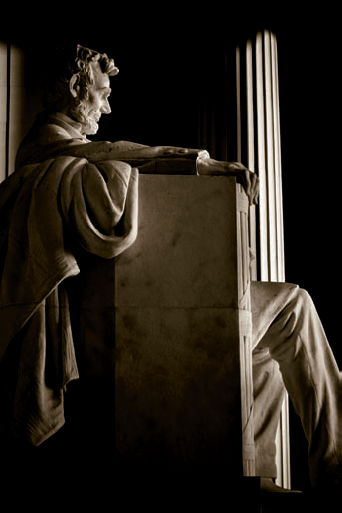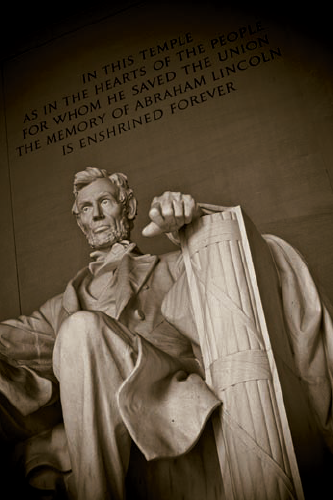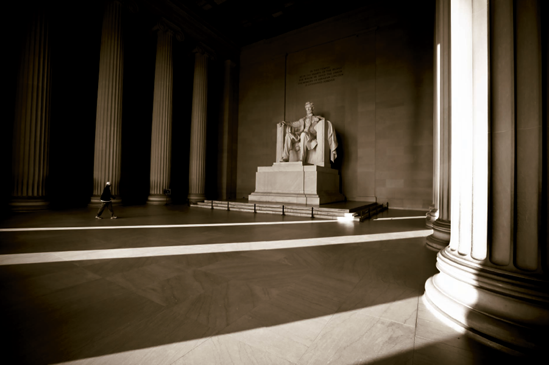
The interior of the Lincoln Memorial as the autumn sun rises. Taken at ISO 400, f/10,1/100 second with a 16mm lens.
The Neoclassical temple of the Lincoln Memorial is a tribute to Abraham Lincoln, sixteenth president of the United States. President Lincoln oversaw the end of the American Civil War and the reuniting of the Confederate and Union states under one flag, as well as the ending of slavery through his Emancipation Proclamation.
There are great vantage points of the Lincoln Memorial from several areas; the locations described here concentrate on areas where the sculpture of Lincoln is viewable within the photograph.
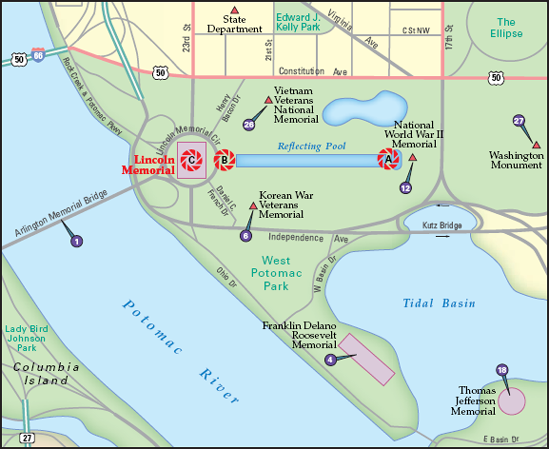
Figure 7.1. The best locations from which to photograph the Lincoln Memorial: (A) east end of the Lincoln Reflecting Pool, (B) east side of the memorial, and (C) inside the memorial. Nearby photo ops: (1) Arlington Memorial Bridge, (4) Franklin Delano Roosevelt Memorial, (6) Korean War Veterans Memorial, (12) National World War II Memorial, (18) Thomas Jefferson Memorial, (26) Vietnam Veterans National Memorial, and (27) Washington Monument.
Looking out over the Lincoln Reflecting Pool offers a nice view of the memorial during most any time of the day (see Figure 7.1). Here, you can photograph the memorial using a wider lens to get the trees that line the pool, or you can use a longer lens to capture the memorial's reflection in the water. You'll be standing just between the Reflecting Pool and the World War II Memorial — by facing toward the Washington Monument, you get a great vantage point looking east as well.
Closer in to the memorial, there are a number of ways to photograph it. The first is to get an overall shot of its exterior (see Figure 7.2), while other images (such as Figure 7.3) can include the details of the building along with the statue, or just images of its many architectural features.
It's definitely worth a walk around the inside of the Lincoln Memorial to read his words, view the paintings, and take in the grand spectacle before you. Figures 7.4 and 7.5 can be done to a varying degree at anytime during the day.
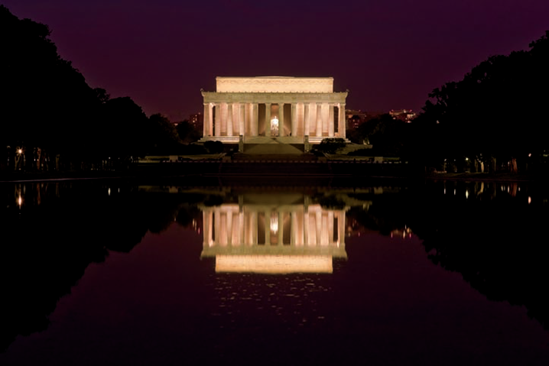
Figure 7.2. Looking west across the Lincoln Reflecting Pool in the morning (see A on the map). Taken at ISO 250, f/11, 6 seconds with a 120mm lens mounted on a tripod.

Figure 7.3. The east side of the Lincoln Memorial just at sunrise (see B on the map). Taken at ISO 400, f/18, 5 seconds with a 35mm lens and a tripod.
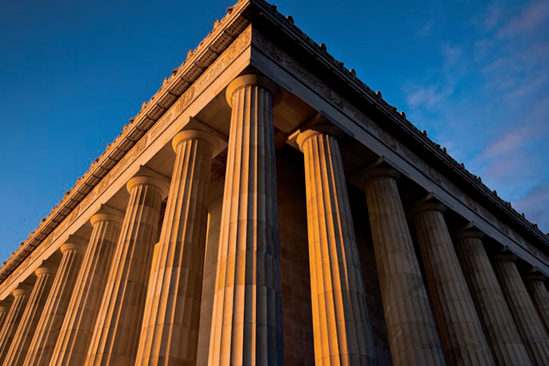
Figure 7.4. A detail image of the Lincoln Memorial's exterior (see B on the map). Taken at ISO 125, f/8, 1/80 second with a 28mm lens.
Plan to spend some time at the Lincoln Memorial, whether it is for photography or just taking it all in. Of all D.C.'s memorials, the Lincoln stands out by virtue of its welcoming and majestic setting that allures people to sit on its steps and linger for hours.
A variety of different images can be taken here using many different focal lengths.
When looking across the Lincoln Reflecting Pool (refer to Figure 7.1), focal lengths between 50–200mm can be used, depending on how wide or tight you want to shoot. As you get closer to the memorial and are working on the west side of the Reflecting Pool, a standard 35mm lens works well to capture the front of the memorial from the area below the last set of stairs, next to the cement blocks that form the border between Lincoln Memorial Circle. Inside the memorial, the images vary from quite wide (20mm) to rather tight (100–120mm).
Adjusting the exposure of the sky by using a graduated neutral density can work well here, depending on how bright the sky is and how much of it is in your composition. Otherwise, using a software-based graduated filter to adjust contrast in your image can help balance out areas of extreme contrast. For example, if you are photographing the exterior of the memorial during the day, often the statue within the memorial will be quite dark.
Sometimes the exposure will just be too extreme (especially in periods of bright, late morning sun), but by reducing the exposure on the outside of the building using a software-based graduated filter, you can balance out the brightness to some degree. Also, when photographing details of the building that include sky, a polarizing filter can help darken and increase the saturation of the sky and the contrast with the clouds.
Tripods are not allowed within the Lincoln Memorial, or any part of its marble exterior. The general rule explained by the guards here is that they aren't to be used until after the second set of stairs that lead to the entrance of the memorial. As with all the major landmarks in D.C., the rules may change from time to time, so it's best to ask a guard or National Park Service official at the monument to double-check. A very small, table-top tripod is a good alternative for areas of the memorial where regular tripods are not allowed.
Tip
Carry a piece of newspaper to put under small tripods so they don't touch the memorial.
You can also use a table-top tripod to capture the front exterior shot (refer to Figure 7.2) by placing it on one of the cement blocks along Lincoln Memorial Circle. This can be a great weight and space saving idea if you choose not to carry a full-size tripod.
Tip
A polite greeting and an inquiry to a staff member about where tripods may be used at such venues is a good idea at such popular locations. By doing so, you'll often get a few tips about good locations and other helpful information as well.
The important thing to remember at the Lincoln Memorial is that you'll often be photographing areas of great contrast, especially inside the monument. If you are using your camera's Priority modes, you may have to adjust the exposure compensation to get your desired look because of the brightness of the memorial.
For example, when looking into the memorial from its steps (see Figure 7.6), the areas outside are very bright and reflect a lot of light, while the interior of the memorial is quite dark. You want to get an exposure that balances the two, which often means a compromise between either light or dark.
Figure 7.6 has areas of very dark tones and very light ones, and it was important to preserve some details inside while keeping the outside from being too bright. This is a situation that will fool many a camera's meter, so do some test shots and adjust your exposure up or down by using the exposure compensation feature.
If you want to do long exposures on a tripod, logic says to use Shutter Priority mode to set a long shutter speed. However, many cameras compensate by setting a very low aperture value. Instead, you can trick your camera into using a long shutter speed by using Aperture Priority mode and then setting a high aperture value of, say, f/16 if it is at night. With a low ISO setting between 100 and 400, your camera will then set a fairly long shutter speed. Also, if your camera has a Night mode, that may work well, too.
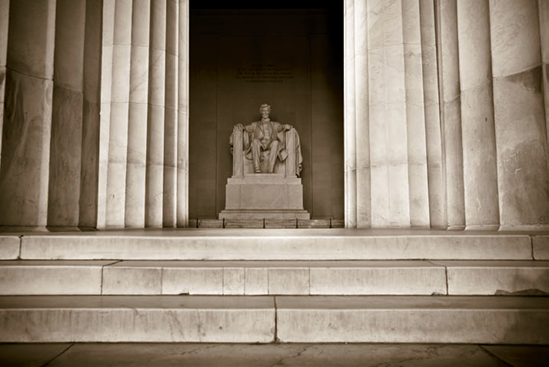
Figure 7.7. Looking into the Lincoln Memorial's entrance (see B on the map). Taken at ISO 100, f/4.5, 1/100 second using a 28mm lens.
No matter what you do, turn your flash off when you are here. You want to use either natural light to photograph the statue inside, or the decently bright spotlights on the statue itself. On-camera flash used on the statue can turn the otherwise beautiful work of art into something quite garish. When looking out across the mall from the memorial, having a flash on will do nothing but waste your batteries and possibly get a very bright fellow visitor in the frame.
There are great photo opportunities here year-round and basically all day and night (see Figure 7.7).
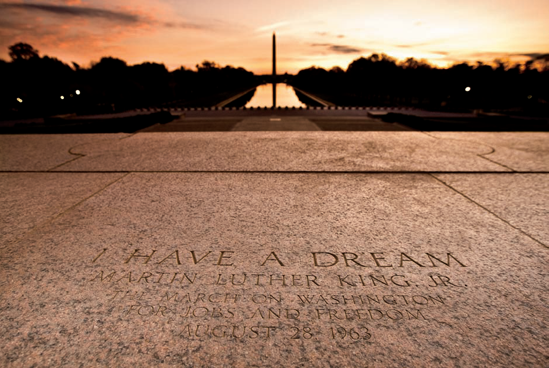
Figure 7.8. Martin Luther King, Jr. gave his I Have a Dream speech to over 200,000 civil rights supporters on the steps of the Lincoln Memorial in 1963 (see B on the map). Taken at ISO 800, f/4, 1/50 second with a 20mm lens.
The Lincoln Memorial is by the far one of the most visited monuments in D.C. There's a good chance that when you are there, many other visitors will be, too. During peak tourist times, there will be hundreds of people inside and outside the memorial. You can actually use this to your advantage; people turn the area into something akin to Paris's Montmartre on a warm summer's evening. But, if you're looking to get images that aren't crowded with people, think either early morning or at night. It's open all the time, so there's plenty of time to explore.
The memorial faces due east, and it is nothing short of spectacular to watch the sun rise over the Capitol, the National Mall, Smithsonian Castle, Washington Monument, and finally the World War II Memorial. During the morning from spring through late summer, the rising eastern sun spills into the inside of the memorial. Figure 7.8 shows the statue of President Lincoln illuminated in early sunlight.
If the weather isn't cooperating, you can take plenty of good shots inside the memorial, so you could concentrate your efforts there. Otherwise, try to take advantage of what you are given: If there are big clouds and a blue sky, use those as part of your composition with architectural details. If, however, there is a lot of direct sun, you may have to limit your exterior images if you're also trying to get the statue in the photos — the contrast will likely be too great. Overcast days are therefore great here because the lack of contrast means more opportunities for displaying the exterior and interior areas in the same shot.
The Lincoln Memorial is an absolutely great subject at night for two reasons: The statue stands out in a dark night brilliantly, and there are often fewer people to contend with. There are also fantastic images to be taken of the National Mall from the Lincoln at night as well.
Interior images of the Lincoln statue at night require a high ISO to avoid using flash. On-camera built-in and accessory flashes will cast a large shadow behind the statue of Lincoln and are only really powerful enough to partially light the statue, so it's best to avoid using one. Inside photos at night work well because the background goes very dark and helps the Lincoln statue to stand out well. More modern cameras with quality high ISO settings and faster lenses (with lower aperture values) will make this easier, because tripods are not allowed here. No matter what, use a steady hand and take several pictures in a row if you are using slower shutter speeds, to ensure that you get at least one frame tack sharp and free of camera-shake blur.
There are many more ways to photograph the Lincoln Memorial, and some are clearly reminiscent of famous photographs of the Parthenon in Greece (see Figure 7.9).
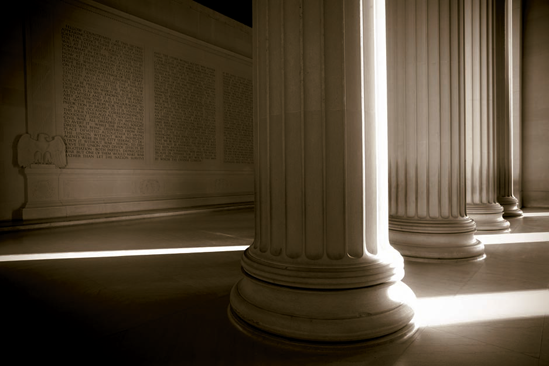
Figure 7.10. Explore all the angles when inside the Lincoln Memorial. Here the north wall is seen with the morning sun casting across it (see C on the map). Taken at ISO 500, f/5, 1/60 second with a 20mm lens.
As you can see also from the toned black-and-white photographs featured in this chapter, the Lincoln Memorial's subtle gradations of light inside during the day and the artificial light at night work well for such styles of photography.
Finally, try tilting your camera a bit to change the composition of your images. While it may annoy some purists to no end, doing so can also help to create a more interesting and dynamic composition, if used cautiously, of the Lincoln statue (see Figure 7.10).

